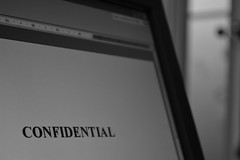 |
| Seal of the United States Department of Education (Photo credit: Wikipedia) |
Today, the
United States Department of Eucation issued 15 principles concerning
seclusion and restraint. The document amount to suggestions to states and school districts in formulating their own policies on seclusion and restraint. NOTE: these principles are not a law or regulation, or even policy guidance, they are instead merely suggestions. But I am already wondering what impact these principles may have in practice. Parent advocates and lawyers may cite them as authority when they are not followed. Similarly school lawyers may cite them as a shield when a district's policy is similar or more protective. Often in this area of law the usual rules regarding precedent and hornbook rules get a little fuzzy. Also I am wondering if seclusion and restraint cases, like the bullying cases, might have horrendous fact patterns. Following my previous train of thought in previous posts these cases might water down the Rowley "some benefit" standard. Thoughts?
The accompanying
press release states, "{t}he 15 principles that frame the document ultimately highlight how
schoolwide behavioral interventions can significantly reduce or
eliminate the use of restraint or seclusion. These guiding principles
offer states, districts and other education leaders a framework for
developing appropriate policies related to restraint and seclusion to
ensure the safety of adults and children.
'Ultimately, the standard for educators should be the same standard
that parents use for their own children,” Duncan added. “There is a
difference between a brief time out in the corner of a classroom to
help a child calm down and locking a child in an isolated room for
hours. This really comes down to common sense.' ”
Here are the 15 principles:
1. Every effort should be made to prevent the need for the use of restraint and for the use of seclusion.
2. Schools should never use mechanical restraints to restrict a child’s freedom of movement, and
schools should never use a drug or medication to control behavior or restrict freedom of
movement (except as authorized by a licensed physician or other qualified health professional).
3. Physical restraint or seclusion should not be used except in situations where the child’s behavior poses imminent danger of serious physical harm to self or others and other interventions are ineffective and should be discontinued as soon as imminent danger of serious physical harm to self or others has dissipated.
4. Policies restricting the use of restraint and seclusion should apply to all children, not just children with disabilities.
5. Any behavioral intervention must be consistent with the child’s rights to be treated with dignity
and to be free from abuse.
6. Restraint or seclusion should never be used as punishment or discipline (e.g., placing in
seclusion for out-of-seat behavior), as a means of coercion or retaliation, or as a convenience.
7. Restraint or seclusion should never be used in a manner that restricts a child’s breathing or
harms the child.
8. The use of restraint or seclusion, particularly when there is repeated use for an individual
child, multiple uses within the same classroom, or multiple uses by the same individual, should
trigger a review and, if appropriate, revision of strategies currently in place to address
dangerous behavior;8 if positive behavioral strategies are not in place, staff should
consider developing them.
9. Behavioral strategies to address dangerous behavior that results in the use of restraint or
seclusion should address the underlying cause or purpose of the dangerous behavior.
10. Teachers and other personnel should be trained regularly on the appropriate use of effective
alternatives to
physical restraint and seclusion, such as positive behavioral interventions and
supports and, only for cases involving imminent danger of serious physical harm, on the safe use
of physical restraint and seclusion. Every effort should be made to prevent the need for the use
of restraint and for the use of seclusion.
11. Every instance in which restraint or seclusion is used should be carefully and continuously and visually monitored to ensure the appropriateness of its use and safety of the child, other children, teachers, and other personnel.
12. Parents should be informed of the policies on restraint and seclusion at their child’s school or other educational setting, as well as applicable Federal, State, or local laws.
13. Parents should be notified as soon as possible following each instance in which restraint or seclusion is used with their child.
14. Policies regarding the use of restraint and seclusion should be reviewed regularly and updated as appropriate.
15. Policies regarding the use of restraint and seclusion should provide that each incident involving the use of restraint or seclusion should be documented in writing and provide for the collection of specific data that would enable teachers, staff, and other personnel to understand and implement the preceding principles.
You can read the entire document
here.



















































